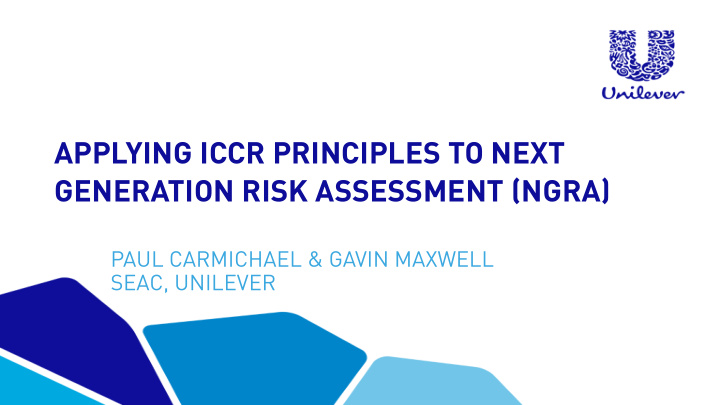



APPLYING ICCR PRINCIPLES TO NEXT GENERATION RISK ASSESSMENT (NGRA) PAUL CARMICHAEL & GAVIN MAXWELL SEAC, UNILEVER
WHAT IS THE ICCR? The I nternational C ooperation on C osmetics R egulation 5 member regulators (Brazil, Canada, EU, Japan, USA) providing a multilateral framework to maintain and enable: • High level of global consumer protection • Promoting regulatory convergence • Minimizing barriers to international trade https://www.iccr-cosmetics.org/ 2
BACKGROUND TO JOINT WORKING GROUP • Non- animal test data can no longer be considered ‘alternative’ • Basing a risk assessment on non-animal test data requires a fundamental change in approach • Because science in this area is rapidly evolving, formal guidance for cosmetic ingredients is not yet available 3
JOINT WORKING GROUP ON INTEGRATED STRATEGIES A group of scientists from regulatory authorities and industry tasked by the ICCR Steering Committee to outline the principles that underpin the use of novel methods and data in cosmetic ingredient risk assessment (Next Generation Risk Assessment)
ICCR NINE PRINCIPLES OF NGRA Main overriding principles: The overall goal is a human safety risk assessment The assessment is exposure led The assessment is hypothesis driven The assessment is designed to prevent harm Principles describe how a NGRA should be conducted: Following an appropriate appraisal of existing information Using a tiered and iterative approach Using robust and relevant methods and strategies Principles for documenting NGRA: Sources of uncertainty should be characterized and documented The logic of the approach should be transparent and documented
JOINT WORKING GROUP TASK 2 Provide further information on the types of new methodologies that may be useful in the risk assessment of cosmetics (Part 2) For the benefit of risk assessors more familiar with traditional toxicological datasets ➢ Which approaches can be used? ➢ What are their strengths and limitations? ➢ Where could they be used in the risk assessment?
ONE EXAMPLE NGRA WORKFLOW Continue through tiers until sufficient information to make a decision: assessment may be complete at any tier Berggren et al., (2017) Computational Toxicology 4: 31-44. https://doi.org/10.1016/j. comtox.2017.10.001 7
ONE EXAMPLE NGRA WORKFLOW Read across Exposure-based waiving In silico tools Metabolism and metabolite identification Physiologically-based kinetic modelling In chemico assays ‘Omics Reporter gene assays In vitro pharmacological profiling 3D culture systems Organ-on-chip Pathways modelling Human studies 8
ONE EXAMPLE NGRA WORKFLOW Read across Exposure-based waiving In silico tools Metabolism and metabolite identification Physiologically-based kinetic modelling In chemico assays ‘Omics Reporter gene assays In vitro pharmacological profiling 3D culture systems Organ-on-chip Pathways modelling Human studies 9
CONCLUSION • Workflows like the SEURAT ‐ 1 ab initio workflow provide a flexible framework upon which to build an NGRA • These frameworks can be used in a way that exemplifies the 9 ICCR principles • Using exposure ‐ led frameworks it is possible that for cosmetic ingredients some of the higher ‐ tier approaches may only rarely be needed 10
NEXT GEN. RISK ASSESSMENT FOR SKIN ALLERGY: USE OF 0.1% COUMARIN IN FACE CREAM SEAC Unilever Information: Internal Use 11
NEXT GEN. RISK ASSESSMENT FOR SKIN ALLERGY: STEP 1 - IDENTIFY USE SCENARIO SEAC Unilever Information: Internal Use 12
NEXT GEN. RISK ASSESSMENT FOR SKIN ALLERGY: STEP 2: IDENTIFY MOLECULAR STRUCTURE SEAC Unilever Information: Internal Use 13
NEXT GEN. RISK ASSESSMENT FOR SKIN ALLERGY: STEP 3: COLLECT EXISTING DATA SEAC Unilever Information: Internal Use Ref: Hoffmann S. et al . 2018. 14
NEXT GEN. RISK ASSESSMENT FOR SKIN ALLERGY: STEP 8: DERIVE A POINT OF DEPARTURE SEAC Unilever Information: Internal Use Ref: Reynolds, J.. et al . 2019. 15
NEXT GEN. RISK ASSESSMENT FOR SKIN ALLERGY: STEP 8: DERIVE A POINT OF DEPARTURE SEAC Unilever Information: Internal Use Ref: Reynolds, J.. et al . 2019. 16
NEXT GEN. RISK ASSESSMENT FOR SKIN ALLERGY: STEP 8: DERIVE A POINT OF DEPARTURE SEAC Unilever Information: Internal Use Ref: Reynolds, J.. et al . 2019. 17
NEXT GEN. RISK ASSESSMENT FOR SKIN ALLERGY: STEP 9: RISK ASSESSMENT DECISION SEAC Unilever Information: Internal Use 18
SEAC Unilever Information: Internal Use 19
Recommend
More recommend